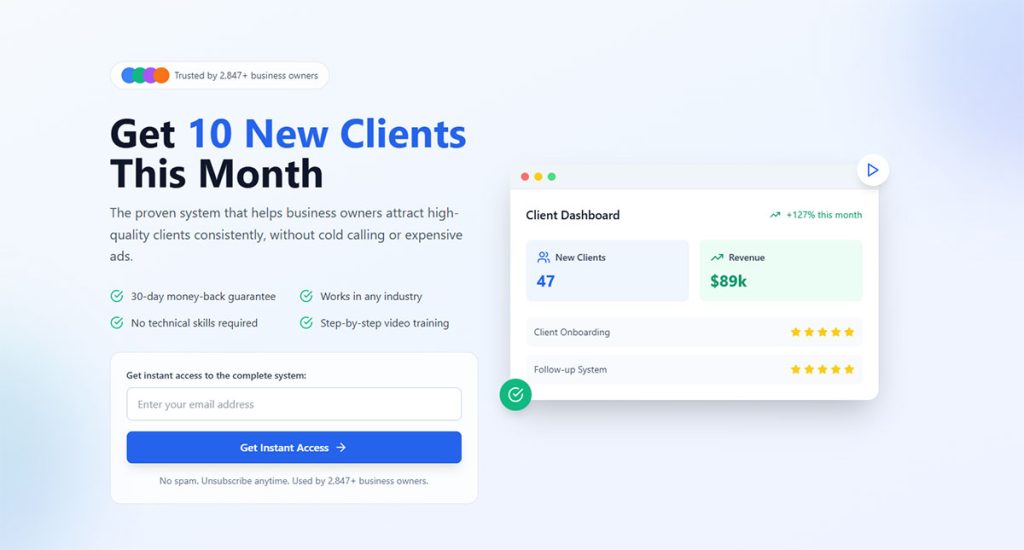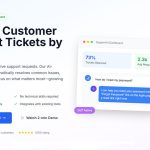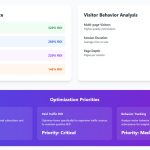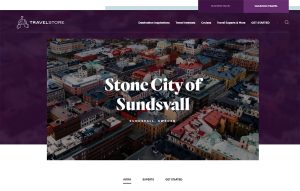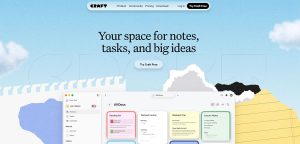Your website gets traffic, but your calendar stays empty. Lead generation for travel companies isn’t about attracting more visitors. It’s about converting browsers into bookers. Most travel businesses waste money…
Table of Contents
Your email list sits empty while competitors build engaged audiences daily. What is a lead magnet exactly, and why do successful businesses swear by them?
A lead magnet is a valuable free resource offered in exchange for contact information. Think ebooks, templates, or exclusive access that solves specific problems for your target audience.
Smart marketers use lead magnets to transform website visitors into engaged subscribers. These digital marketing tools capture qualified prospects while building trust through immediate value delivery.
This guide reveals how lead magnets drive email list building and customer acquisition. You’ll discover proven formats, creation strategies, and promotion tactics that convert browsers into buyers.
Ready to build your audience systematically? Let’s explore lead generation strategies that actually work.
What Is a Lead Magnet?
A lead magnet is a free resource or incentive offered to potential customers in exchange for their contact information, usually an email address. Common examples include eBooks, checklists, templates, or discounts. It’s designed to attract and convert website visitors into leads for future marketing efforts.
Types of Lead Magnets That Actually Work
The best lead magnets solve real problems. Your audience craves solutions, not fluff.
Quick Stats: The average lead magnet landing page converts at 18%, while general landing pages average only 6.6%. Companies using lead magnets report 50% higher conversion rates.
Educational Lead Magnets
Ebooks and Comprehensive Guides
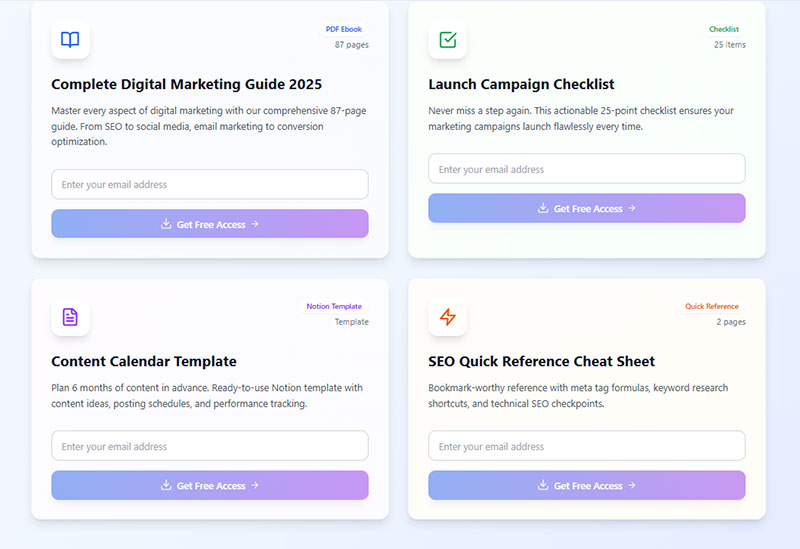
Ebooks dominate the digital marketing landscape. They establish authority while delivering deep value. Think industry reports, complete how-to manuals, or detailed strategy breakdowns.
The numbers speak volumes:
- 27.7% of marketers use ebooks as their primary lead magnet
- Short-form ebooks achieve 100% conversion rates according to 55.9% of businesses
- Long-form guides hit 67.2% conversion rates (77% of businesses confirm this)
Keep them focused. The sweet spot is 5,000-10,000 words or under 30 pages for better conversion.
Checklists and Step-by-Step Templates
People love actionable content. A marketing campaign checklist beats a generic marketing ebook every time.
Quick reference materials work because they save time. 58.6% of marketers confirm that short-form written content like checklists produces the highest conversion rates.
Cheat Sheets
Perfect subscriber incentives for complex processes. Your audience bookmarks these resources.
Cheat sheet landing pages convert at an average of 34%, with top performers reaching 66% conversion rates.
How-to Videos and Mini-Courses
Visual learners love these formats. 47% of marketers find video and text-based lead magnets as top opt-in performers.
Video performance breakdown:
- 73% of marketers see higher conversion rates with short-form videos
- Only 27% achieve better results with long-form video content
These work exceptionally well for software tutorials, cooking techniques, or fitness routines.
Tools and Resources
Calculators and Interactive Tools
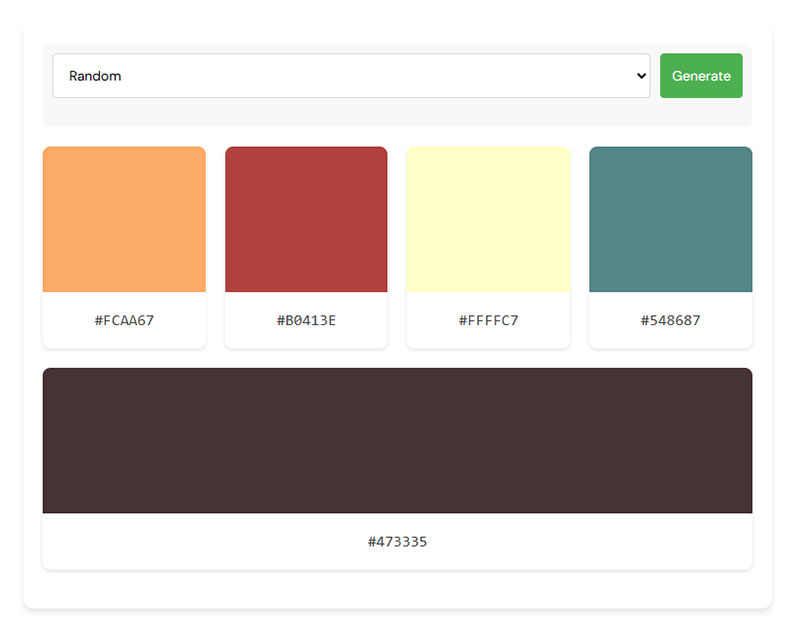
Image source: Design Your Way’s Color Palette Generator
Provide immediate value. ROI calculators, mortgage estimators, or calorie counters solve specific problems instantly.
Real success story: One fence company generated 45% of their 2024 revenue from a single ROI calculator funnel, achieving:
- 2.7x conversion rate increase
- 52% faster lead-to-sale cycle
- 34% higher average contract value
Template kits for startups show 72% increase in email captures versus traditional downloadable guides.
Software Trials and Exclusive Access
Work exceptionally well for SaaS companies. Free trials convert better when positioned as premium access rather than basic demos.
Mobile apps and browser extensions extend your brand into daily routines. These require significant development but create lasting engagement.
Content-Based Lead Magnets
Email Courses and Newsletter Series
Build relationships over time. Seven-day challenges or weekly industry insights keep subscribers engaged through consistent value delivery.
Webinars and Live Training Sessions
The conversion champions. Limited attendance drives immediate action.
Webinar performance stats:
- 70.2% conversion rate (highest among long-form video content)
- Average attendee conversion rate: 55%
- Training webinars: 44% conversion rate
- Communication webinars: 67% conversion rate
- 73% of B2B attendees become qualified leads
- 15% of attendees purchase the product or service
Attendance reality check: 35-45% of registrants attend live sessions, but many watch replays later.
Recording access sweetens the deal and extends your reach.
Podcasts and Audio Content
Serve commuters and multitaskers. Interview series or audio tutorials work particularly well for busy professionals.
Case Studies and Research Reports
Appeal to data-driven decision makers. Original research positions you as an industry authority.
Exclusive Offers and Incentives
Discount Codes and Special Pricing
Drive immediate purchases. First-time buyer discounts or exclusive member pricing create urgency.
Contest-based lead magnets achieve 35% form conversion rates compared to 11% for general lead generation forms.
Free Consultations
Perfect for service businesses. Strategy sessions or audit calls qualify prospects while demonstrating expertise.
Product Samples
Eliminate purchase risk. Physical samples for beauty products or digital samples for courses reduce barriers to entry.
Members-Only Content
Creates exclusivity. Private communities or premium resources make subscribers feel special.
Creating Lead Magnets That People Actually Want
Most lead magnets fail because they solve imaginary problems. Success starts with real audience research.
Research Your Target Audience
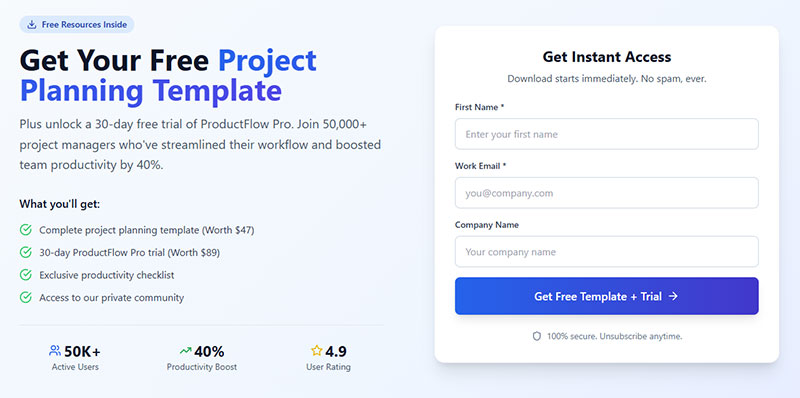
Finding your audience’s biggest problems requires active listening. Social media comments, customer support tickets, and sales calls reveal genuine pain points.
Check competitor comments sections. What questions appear repeatedly? These represent content gaps you can fill.
Survey existing customers about their challenges before finding your solution. Their answers guide lead magnet creation.
Understanding what solutions they’re already seeking means analyzing search behavior. Keyword research tools reveal what your audience actually searches for.
Google Suggest and “People Also Ask” sections provide goldmine insights. These represent real search queries from real people.
Identifying gaps in existing free content means auditing competitor offerings. What problems remain unsolved? Where do current resources fall short?
Choose the Right Lead Magnet Format
Matching format to your audience’s preferences determines success. Busy executives prefer checklists over lengthy ebooks. Visual learners choose infographics over text-heavy guides.
Industry matters tremendously. Financial advisors succeed with calculators. Fitness coaches excel with workout plans. Software companies win with free trials.
Considering your industry and business type prevents format mismatches. B2B audiences prefer professional whitepapers. B2C audiences engage with interactive quizzes.
Evaluating your available resources and skills keeps projects realistic. Video production requires different skills than ebook creation. Start with your strengths.
Create Compelling Titles and Headlines
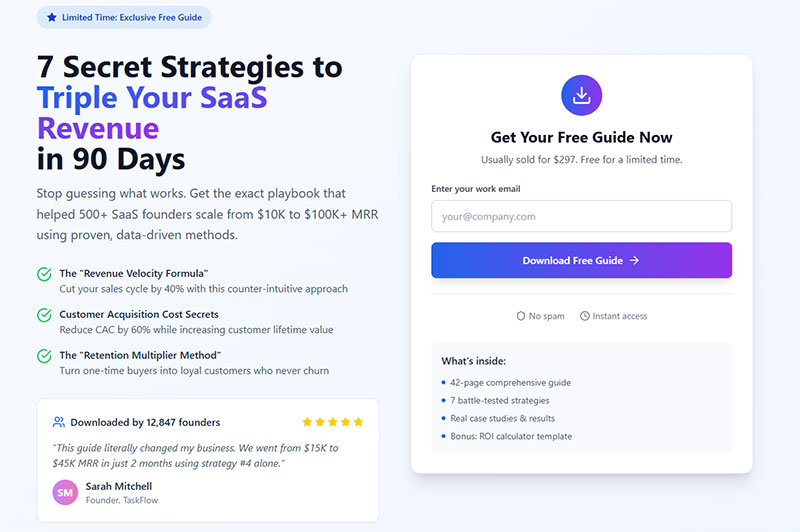
Using specific numbers and timeframes increases credibility. “7 Ways to Increase Sales” outperforms “Ways to Increase Sales.” Specificity suggests proven systems.
Odd numbers convert better than even numbers. “5 Tips” beats “4 Tips” consistently across industries.
Addressing pain points directly connects immediately. “Stop Wasting Money on Facebook Ads” speaks to frustrated advertisers. Direct language cuts through noise.
Power words grab attention naturally. Words like “secret,” “ultimate,” “proven,” and “exclusive” create emotional responses.
Testing different headline variations prevents guesswork. A/B testing reveals which headlines resonate with your specific audience.
Headlines determine whether people download your lead magnet. Invest time here.
Design and Content Best Practices
Making your lead magnet easy to consume prevents abandonment. Wall-of-text PDFs get deleted quickly. Break content into digestible sections.
White space improves readability dramatically. Dense layouts overwhelm readers. Clean design communicates professionalism.
Focusing on one main problem or solution maintains clarity. Swiss Army knife lead magnets solve nothing well. Laser focus wins.
Including actionable steps and clear instructions delivers immediate value. Generic advice disappoints. Specific guidance gets implemented.
Number your steps. Use bullet points liberally. Make following instructions effortless.
Professional design that reflects your brand builds trust instantly. Consistent colors, fonts, and styling reinforce brand recognition. Amateur design undermines credibility.
Templates from design platforms work for non-designers. Consistent branding matters more than artistic perfection.
Consider mobile users throughout design. Many people access lead generation forms on smartphones. Responsive design isn’t optional.
Setting Up Your Lead Magnet System
Technical setup determines conversion success. Poor systems kill great lead magnets.
Creating High-Converting Landing Pages
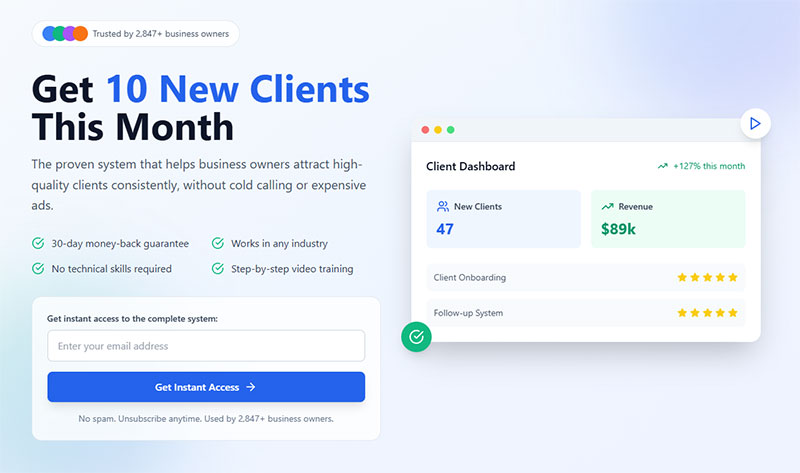
Writing headlines that match your lead magnet prevents confusion. Consistency builds trust. Your headline should mirror your promotion copy exactly.
Split test headlines ruthlessly. Small changes create massive conversion differences.
Explaining the value clearly and quickly captures attention immediately. Visitors decide within seconds. Bullet points work better than paragraphs here.
Focus on benefits, not features. “Get 10 new clients this month” beats “Comprehensive client acquisition guide.”
Using social proof and testimonials reduces risk perception. Real names and photos increase credibility significantly. Specific results outperform generic praise.
Industry recognition and media mentions work exceptionally well for B2B audiences.
Keeping forms simple and minimal reduces abandonment. Email address alone often suffices. Each additional field decreases conversions dramatically.
Name and email typically maximize both quantity and quality. Test single-field versus multi-field approaches for your audience.
Email Automation and Follow-Up Sequences
Setting up immediate delivery systems prevents frustration. Delayed delivery kills momentum. Automate everything possible.
Thank you pages should confirm delivery and set expectations. Include download links as backup options.
Creating welcome email sequences nurtures new subscribers effectively. First impressions matter enormously. Plan your first five emails carefully.
Welcome sequences typically perform better than single welcome emails. Spread value across multiple touchpoints.
Planning long-term nurture campaigns maintains engagement over time. Most conversions happen after multiple touchpoints. Plan content months ahead.
Mix educational content with promotional messages. The 80/20 rule works well here.
Segmenting leads based on their interests improves relevance dramatically. Different lead magnets attract different buyer personas. Tag subscribers accordingly.
Segmentation enables personalized follow-up sequences. Relevant content increases engagement rates significantly.
Technical Setup and Integration
Connecting your email service provider enables automation. Choose platforms that integrate with your existing tools. Migration later costs time and money.
Popular options include ConvertKit, Mailchimp, and ActiveCampaign. Each serves different business sizes and complexity needs.
Setting up tracking and analytics reveals optimization opportunities. Google Analytics tracks landing page performance. Email platforms monitor delivery rates.
Conversion tracking identifies bottlenecks quickly. Monitor every step from click to signup.
Creating mobile-friendly experiences captures smartphone traffic. Over 60% of email opens happen on mobile devices. Responsive design isn’t optional.
Test your entire funnel on multiple devices. Poor mobile experience destroys conversion rates.
Testing all systems before launch prevents embarrassing failures. Send test emails to yourself. Complete the entire signup process manually.
Broken download links frustrate new subscribers immediately. Check everything twice.
Promoting Your Lead Magnets Effectively
Great lead magnets need strategic promotion. Build it and they won’t necessarily come.
Website Integration Strategies
Adding opt-in forms to high-traffic pages captures existing visitors. About pages and blog posts receive significant traffic. Contact form integration works particularly well.
Sidebar forms catch attention without disrupting reading experience. Footer forms capture bottom-of-page visitors.
Using pop-ups and slide-ins strategically increases visibility dramatically. Exit-intent triggers capture abandoning visitors. Time-based triggers engage reading visitors.
Popup forms convert well when timed correctly. Test different triggers for your audience.
Creating dedicated landing pages focuses visitor attention completely. Remove navigation distractions. Single purpose pages convert better.
SEO-optimized landing pages attract organic search traffic. Target long-tail keywords related to your lead magnet topic.
Including calls-to-action in blog content uses existing content. Contextual offers convert better than generic sidebar ads.
Content upgrades related to blog topics perform exceptionally well.
Social Media Promotion
Sharing lead magnets across platforms expands reach significantly. Different platforms attract different demographics. Tailor messaging accordingly.
LinkedIn works well for B2B lead magnets. Instagram suits visual content. Facebook enables detailed targeting.
Creating platform-specific content teasers increases engagement. Native content outperforms obvious promotions. Provide value first, promote second.
Behind-the-scenes content builds anticipation effectively. Show creation process snippets.
Using social proof and user-generated content builds credibility organically. Customer testimonials and success stories encourage downloads.
Encourage subscribers to share results publicly. Social proof multiplies promotional effectiveness.
Running targeted social media ads accelerates growth. Organic reach limitations make paid promotion necessary. Start with small budgets and scale winners.
Retargeting website visitors costs less than cold audiences. Warm traffic converts better consistently.
Content Marketing and SEO
Writing blog posts that support your lead magnet creates natural promotion opportunities. Educational content attracts ideal prospects. Include relevant calls-to-action throughout.
Solve related problems in blog content. Position your lead magnet as the next logical step.
Guest posting and collaboration opportunities expand audience reach. Other people’s audiences represent untapped potential. Provide value first, promote appropriately.
Podcast appearances work exceptionally well for service businesses. Audio content builds trust quickly.
Creating video content and tutorials engages visual learners effectively. YouTube represents the second largest search engine. Video content ranks well in Google too.
Tutorial videos showcase expertise while promoting lead magnets naturally.
Building backlinks to your landing pages improves search rankings. High-quality backlinks increase organic traffic significantly. Focus on relevant, authoritative sites.
Resource pages and tool directories provide link opportunities. Outreach to industry publications works well.
Paid Advertising Approaches
Google Ads for search traffic captures high-intent visitors. People searching for solutions are ready to download resources. Target problem-focused keywords.
Long-tail keywords cost less and convert better. “How to generate leads without cold calling” beats “lead generation.”
Facebook and Instagram advertising enables precise demographic targeting. Interest-based targeting reaches relevant audiences efficiently. Lookalike audiences expand successful campaigns.
Video ads often outperform static images on social platforms.
LinkedIn ads for B2B lead magnets reach professional audiences effectively. Higher costs are offset by better lead quality typically. Job title targeting works exceptionally well.
Sponsored content blends naturally with organic posts. Direct message ads feel more personal.
Retargeting website visitors recaptures lost opportunities. Most visitors leave without converting initially. Retargeting brings them back cost-effectively.
Segment retargeting audiences by pages visited. Different messages for different buyer journey stages improve results.
Measuring Success and Making Improvements
Data drives decisions. Track everything, guess nothing.
Key Metrics to Track
Conversion rates on landing pages reveal optimization opportunities immediately. Industry averages range from 2-5%, but your baseline matters most.
Track by traffic source. Social media visitors convert differently than Google searchers.
Email open and click-through rates indicate content quality and audience engagement. Open rates above 25% suggest strong subject lines. Click rates above 3% show compelling content.
Benchmark against industry standards while focusing on improvement trends.
Lead quality and engagement levels determine actual business value. High-converting leads matter more than large lists. Track which sources generate paying customers.
Monitor time-to-purchase and customer lifetime value by lead source.
Cost per acquisition across different channels guides budget allocation decisions. Facebook ads might cost $5 per lead while Google Ads cost $15, but Google leads might convert 3x better.
Calculate ROI per channel monthly. Shift budgets toward profitable sources.
Testing and Optimization Strategies
A/B testing headlines and copy improves conversions systematically. Test one element at a time. Headlines typically impact results most dramatically.
Statistical significance requires adequate sample sizes. Rush testing wastes opportunities.
Trying different lead magnet formats reveals audience preferences. Some groups prefer video content while others choose written guides. Let data decide.
Test completely different value propositions, not just design tweaks.
Testing various promotion methods identifies highest-performing channels. Email signatures might outperform social media posts for your audience.
Document testing results systematically. Failed tests provide valuable insights too.
Adjusting follow-up sequences maintains subscriber engagement over time. Welcome series performance degrades without regular updates. Refresh content quarterly.
Monitor unsubscribe patterns. High early unsubscribes suggest mismatched expectations.
Common Problems and Quick Fixes
Low conversion rates typically indicate weak value propositions or poor targeting. Strengthen headlines and clarify benefits immediately.
Landing page forms with too many fields kill conversions. Reduce friction first.
High unsubscribe rates after signup suggest delivery problems or unmet expectations. Ensure immediate delivery and match promised value exactly.
Survey unsubscribers about reasons. Their feedback reveals improvement opportunities.
Poor lead quality often results from unclear targeting or generic offers. Specific lead magnets attract qualified prospects better than broad appeals.
Add qualifying questions to registration forms when necessary.
Technical problems affecting delivery frustrate new subscribers instantly. Monitor delivery rates daily. Email providers flag accounts with high complaint rates.
Use authentication protocols like SPF and DKIM. These improve deliverability significantly.
Advanced Lead Magnet Strategies
Scale successful systems. Advanced tactics multiply basic results.
Segmentation and Personalization
Creating multiple lead magnets for different audiences increases relevance dramatically. CFOs need different resources than marketing managers, even within the same company.
Buyer persona research guides lead magnet creation. Interview customers about their specific challenges.
Using quiz-based lead magnets for segmentation personalizes experiences while gathering data. Interactive quizzes engage visitors longer than static forms.
Quiz results enable sophisticated follow-up sequences tailored to individual needs and interests.
Personalizing follow-up content based on interests improves engagement rates significantly. Dynamic content based on download behavior works exceptionally well.
Email marketing automation enables personalization at scale without manual effort.
Dynamic content based on visitor behavior creates custom experiences automatically. Website visitors from LinkedIn see B2B messaging while Facebook visitors see B2C content.
Behavioral triggers enable real-time personalization across all touchpoints.
Lead Magnet Funnels and Sequences
Creating upgrade paths from free to paid guides prospects through buyer journeys naturally. Free lead magnets introduce your expertise while premium offers demonstrate deeper value.
Map content complexity progression. Basic free content leads to advanced paid resources.
Building product launch sequences generates anticipation systematically. Educational content builds authority before promotional messages. Pre-launch surveys identify interested prospects.
Launch sequences convert better than one-time announcements consistently.
Developing educational email courses positions you as a trusted advisor over time. Five-day courses allow deeper relationship building than single downloads.
Course completion rates indicate engagement levels and purchase readiness.
Cross-selling and upselling through email leverages existing relationships cost-effectively. Existing subscribers trust your recommendations more than cold prospects do.
Segment by purchase history. Different offers for first-time buyers versus repeat customers.
Partnership and Collaboration Opportunities
Joint venture lead magnets with other businesses expand audience reach without advertising costs. Partner expertise adds credibility while shared promotion reduces individual effort.
Choose non-competing businesses serving similar audiences. Complementary services work best.
Guest expert contributions and interviews enhance content quality while expanding networks. Expert interviews attract their audiences to your lead magnets.
Provide interview transcripts as lead magnets. Repurpose content across multiple formats.
Industry roundups and collaborative content position you as an industry connector. Comprehensive resource guides citing multiple experts build authority quickly.
Annual industry reports work exceptionally well for B2B audiences.
Affiliate partnerships for lead generation create revenue-sharing opportunities. Partners promote your lead magnets while earning commissions on resulting sales.
Provide promotional materials and tracking links. Make partner success easy to achieve.
Multi-step forms can segment prospects during the signup process itself. Progressive profiling gathers information gradually without overwhelming visitors.
FAQ on Lead Magnets
How do lead magnets work?
Lead magnets exchange valuable content for contact information. Visitors download free resources like ebooks or templates through lead capture forms. This starts email marketing relationships while demonstrating expertise. Automated delivery systems send resources immediately, beginning nurture sequences that convert prospects into customers over time.
What makes a good lead magnet?
Effective lead magnets solve specific problems immediately. They target audience pain points with actionable solutions. Professional design and clear value propositions increase download rates. The best lead magnets relate directly to your products or services, attracting qualified prospects rather than random subscribers seeking freebies.
How long should a lead magnet be?
Length depends on format and audience preferences. Checklists work with 5-10 items. Ebooks typically range from 10-30 pages. Quality beats quantity always. Focus on delivering complete solutions rather than meeting arbitrary page counts. Busy professionals prefer concise, actionable content over lengthy generic guides.
What’s the difference between lead magnets and content marketing?
Content marketing educates broadly while lead magnets capture contacts specifically. Blog posts attract organic traffic through SEO. Lead magnets require sign up forms for access. Both strategies work together, with blog content promoting lead magnets to convert readers into subscribers for ongoing marketing automation.
How much should lead magnets cost to create?
Creation costs vary dramatically by format. Simple checklists cost $50-200 using design tools. Professional ebooks range from $500-2000 with design and writing. Interactive calculators require $1000-5000 for development. Many businesses start with templates and upgrade based on conversion performance and available budgets.
When should businesses use lead magnets?
Lead magnets work best for businesses with longer sales cycles requiring relationship building. Service providers, consultants, and B2B companies benefit most. E-commerce brands use discount codes as lead magnets. Any business needing qualified prospects rather than immediate sales should implement lead generation strategies.
How do you measure lead magnet success?
Track conversion rates, email engagement, and lead quality metrics. Successful landing pages convert 3-15% of visitors. Monitor cost per acquisition across promotion channels. Most importantly, measure sales generated from lead magnet subscribers. Revenue attribution determines actual ROI and guides optimization efforts for maximum business impact.
What are common lead magnet mistakes?
Generic offerings attract unqualified subscribers. Overly broad topics fail to address specific problems. Poor design undermines credibility immediately. Weak calls-to-action reduce downloads. Delayed delivery frustrates new subscribers. Missing follow-up sequences waste captured leads. Always match promises with actual value delivered through your resources.
How often should you create new lead magnets?
Create lead magnets based on audience segments and buyer journey stages. Most businesses start with one primary lead magnet, then expand based on performance data. Seasonal relevance may require quarterly updates. Feedback forms help identify additional topics your audience wants covered.
Can lead magnets work for small businesses?
Small businesses often see better results than large corporations with lead magnets. Limited resources force focus on specific problems. Personal brands build trust faster through valuable free content. Lower competition in niche markets improves conversion rates. Start simple with checklists or templates before investing in complex interactive tools.
Conclusion
Understanding what is a lead magnet transforms how you approach customer acquisition and business growth. These powerful tools convert website visitors into engaged subscribers while building trust through immediate value delivery.
Successful implementation requires strategic thinking beyond simple downloads. Focus on solving real problems for your target audience rather than creating generic resources. Professional execution matters enormously for credibility.
Conversion optimization separates winning campaigns from wasted efforts. Test different formats, headlines, and promotion strategies systematically. Monitor engagement metrics and lead quality consistently.
Start with one well-crafted resource before expanding your arsenal. Contact us page integration and strategic promotion multiply results significantly.
The businesses thriving today built audiences through valuable free content. Your competitors gain advantages daily through systematic lead nurturing and email list building.
Stop losing prospects to competitors. Begin creating your first lead magnet today.


